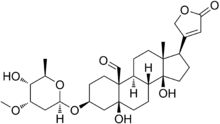Cymarin
 | |
| Clinical data | |
|---|---|
| ATC code | C01AC03 (WHO) |
| Identifiers | |
| |
| Synonyms | Cymarine; K-Strophanthin-α; NSC 7522; Strophantin K; WV 90043a; k-Strophanthin-α |
| CAS Number |
(?) 508-77-0 (?) |
| PubChem (CID) | 441853 |
| ChemSpider |
390429 |
| UNII |
UK3LS8435E |
| ChEMBL |
CHEMBL1651908 |
| ECHA InfoCard | 100.007.353 |
| Chemical and physical data | |
| Formula | C30H44O9 |
| Molar mass | 548.665 g/mol |
| 3D model (Jmol) | Interactive image |
| |
| |
| | |
Cymarin (or cymarine) is a cardiac glycoside. Apocynum cannabinum used as a source of fiber by Native Americans and Apocynum venetum (Chinese: 羅布麻) used as a herbal tea in China both contain cymarin.[1] Cymarin is a cardiac glycoside and an anti-arrhythmia and cardiotonic agent.[2]
References
- ↑ Edible and Medicinal plants of the West, Gregory L. Tilford, ISBN 0-87842-359-1
- ↑ http://pubchem.ncbi.nlm.nih.gov/summary/summary.cgi?cid=539061#x94
This article is issued from Wikipedia - version of the 4/2/2016. The text is available under the Creative Commons Attribution/Share Alike but additional terms may apply for the media files.